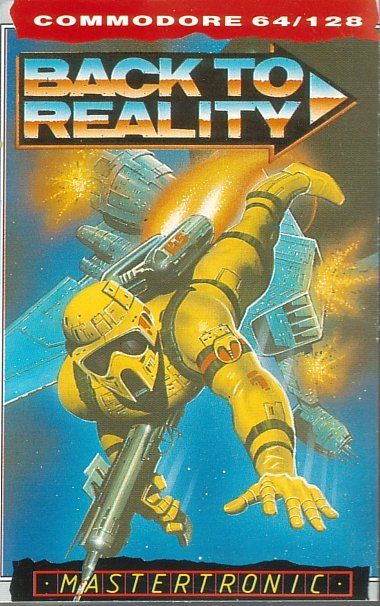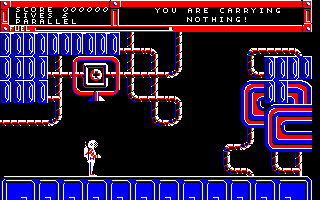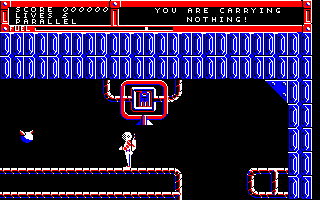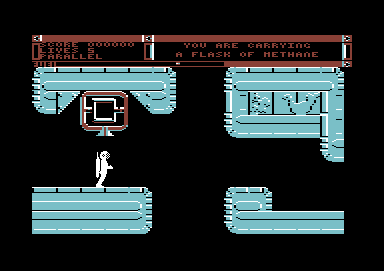Retro Replay Review
Gameplay
Back to Reality challenges players with a tight combination of maze navigation, resource management, and strategic avoidance. As an astronaut equipped with a spacesuit and jetpack, your objective is to find the exit within a sprawling planetary labyrinth. Each room you enter may contain a lurking monster, forcing you to decide whether to evade it or risk a quick dash past it. Touching a monster or using your jetpack both consume precious fuel, turning every decision into a careful balance between speed and conservation.
The fuel mechanic adds a layer of tension to the traditional maze genre. Your jetpack’s thrust can be the difference between escaping an ambush and losing a life. When your fuel gauge is depleted, you don’t just lose movement options—you lose one of your finite lives. This dual-threat system pushes you to master level layouts, memorize monster patrol patterns, and plan your route with surgical precision. Replaying sections becomes part of the fun, as you gradually refine your strategy to maximize fuel efficiency and survivability.
Adding to this complexity are the chemical containers scattered throughout the maze. You can carry a single chemical at a time, but mixing two compatible chemicals yields powerful explosions. These concoctions can clear blocked passages, stun monsters, or reveal hidden pathways. Learning which combinations work together becomes an engaging puzzle in itself, making every container you encounter a potential game-changer. The interplay of fuel management, monster avoidance, and chemical experimentation keeps gameplay fresh throughout your escape attempts.
Graphics
Visually, Back to Reality embraces a sleek, sci-fi aesthetic that immerses you in the claustrophobic corridors of an alien planet. Textures are crisp, with metallic surfaces reflecting the harsh overhead lights of the maze. The dark, shadowy corners are deliberately foreboding, heightening the suspense as you round each turn. Monster designs are suitably alien—each creature has a distinctive silhouette and movement pattern, making identification and avoidance a key part of the visual gameplay loop.
The color palette is dominated by muted grays and cold blues, broken by the bright oranges and yellows of your fuel gauge and chemical containers. This contrast not only draws your eye to critical HUD elements but also reinforces the feeling of isolation and technological reliance. Particle effects from chemical explosions are surprisingly polished, with lingering smoke and glowing debris that linger briefly before fading. These moments of flair stand out against the otherwise sterile environment.
On higher-end systems, the game supports dynamic lighting and subtle post-processing effects that enhance immersion. Flickering lights cast long shadows that shift as you move, creating natural suspense cues. Even on mid-range hardware, the framerate remains stable and the environments feel richly detailed. While it may not rival blockbuster budgets, Back to Reality’s graphics strike an excellent balance between atmosphere and performance.
Story
At its core, Back to Reality tells the story of an astronaut stranded within a hostile, labyrinthine planet. Your survival hinges on escaping the maze before your oxygen—or in this case, your fuel—runs out. The sparse narrative unfolds through environmental storytelling: scattered logs, damaged equipment, and abandoned research stations hint at prior expeditions that met grim fates. These visual breadcrumbs lend depth to your mission and encourage exploration beyond mere escape.
Dialogue is minimal but purposeful, conveyed through mission briefings and intercepted radio transmissions. These snippets of communication reveal the character’s growing desperation, as well as a larger corporate agenda that may have sacrificed safety for scientific gain. The brevity of the narrative lets players focus on the immediate challenge while still feeling invested in uncovering the planet’s secrets. Each new level heightens the stakes, as whispered warnings suggest that something more sinister awaits beyond the next door.
Ultimately, the story’s strength lies in its sense of isolation and discovery. By forgoing lengthy cutscenes or elaborate lore dumps, Back to Reality maintains a tight focus on player agency. You feel like an active participant in piecing together what went wrong, rather than a passive recipient of exposition. This minimalist approach suits the game’s tense, puzzle-driven design, creating a compelling backdrop for your frantic flight to freedom.
Overall Experience
Back to Reality is a masterful blend of tension, strategy, and discovery. The core loop—navigate, evade, conserve fuel, and experiment with chemicals—feels consistently rewarding. Each successful escape from a monster-filled room triggers a small rush of triumph, while every new chemical recipe discovered adds a dash of excitement. The learning curve is approachable but leads to deep mastery, ensuring both casual players and completionists find something to love.
The game’s pacing is one of its standout qualities. Early levels serve as a gentle introduction to the maze and monster mechanics, but by mid-game, you’re juggling intricate routes, scarce fuel, and explosive chemistry puzzles all at once. This escalation keeps the experience from becoming repetitive, and the promise of uncovering more of the planet’s mysteries provides a strong motivation to press onward. Occasional checkpoint placement ensures that frustration never outweighs enjoyment.
Back to Reality’s strengths far outweigh its minor shortcomings. While narrative seekers may wish for a more expansive story, the lean plot is perfectly suited to the gameplay’s fast-paced, high-stakes nature. On the technical side, a handful of texture pop-ins and occasional frame dips on older machines can momentarily break immersion, but they never detract from the overall fun. For fans of maze-based challenges, resource management, and sci-fi atmospheres, Back to Reality is an escape worth undertaking.
 Retro Replay Retro Replay gaming reviews, news, emulation, geek stuff and more!
Retro Replay Retro Replay gaming reviews, news, emulation, geek stuff and more!









Reviews
There are no reviews yet.